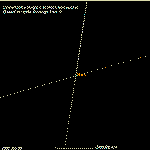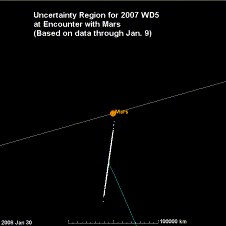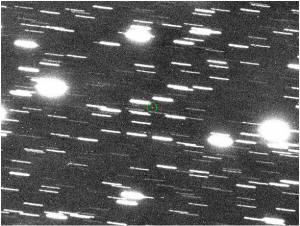|

by Dr Michael Salla
01/11/08
Spanish version
from
Prepare4ContactYahooGroup Website
|
from
Prepare4ContactYahooGroup
Website
Message 36961
Jan 10, 2008
"Dex" <dexxxaa@...>
wrote:
I don't know what this
means, but, I'll tell it anyway...
"The Light of the Second Sun (Son) will be seen in a
few weeks time."
Dex
|
Dex’s prediction is an interesting one
when we consider that an asteroid is due to pass very close to Mars
at the end of this month. According to the latest estimate, the
asteroid will miss by approximately 4000 kilometers.
See below:
2007
WD5 Mars Collision Effectively Ruled Out
Impact Odds now 1 in
10,000
by Steve
Chesley, Paul Chodas and Don Yeomans
NASA/JPL Near-Earth Object
Program Office
January 9, 2008
from
JPLNASA Website
Since our last update, we have received numerous tracking
measurements of asteroid 2007 WD5 from four different
observatories. These new data have led to a significant
reduction in the position uncertainties during the asteroid's
close approach to Mars on Jan. 30, 2008.
As a result, the impact
probability has dropped dramatically, to approximately 0.01% or
1 in 10,000 odds, effectively ruling out the possible collision
with Mars.

Click above image
Animation showing
how the size of the uncertainty region of 2007 WD5
at its encounter
with Mars has decreased over the last 5 weeks as more and more
data were added to the orbit solution.
As shown in an
earlier animation, the region sweeps past Mars from the lower
right to upper left in this view.
In all frames
except the last of this animation, the uncertainty region
intersects Mars as it moves past.
Our best estimate now is that 2007
WD5 will pass about 26,000 km from the planet's center (about 7
Mars radii from the surface) at around 12:00 UTC (4:00 am PST)
on Jan. 30th.
With 99.7% confidence, the pass
should be no closer than 4000 km from the surface.
|
 |
 |
|
Updated
Uncertainty Region for 2007 WD5 at encounter with
Mars, shown as white dots. The thin white line is
the orbit of Mars. The blue line traces the motion
of the center of the uncertainty region, which is
the most likely position of the asteroid.
|
Image of
2007 WD5 from the University of Hawaii 2.2-meter
telescope on Mauna Kea, Hawaii. The circled dot is
the asteroid. Other dots are artifacts from cosmic
rays. The stars are trailed because the telescope is
tracking the asteroid as it moves among the stars.
(Credit: Tholen, Bernardi, Micheli with support from
the National Science Foundation). |
The sequence of updates over the
last few weeks has been typical of past potential impact
scenarios, with the odds of impact initially surging and later
plummeting towards zero.
Early on, the uncertainty region is
very large and the probability of impact is rather low. As the
uncertainty narrows, but still includes the planet, the
probability initially increases.
But eventually, as in this case, the
uncertainty region shrinks to the point that it no longer
overlaps the planet, and the probability of impact begins a
precipitous decline. This rise and fall of the computed hazard
was most notably seen in Dec. 2004 when
asteroid 99942 Apophis
briefly reached a 2.7% chance of impact with Earth in April
2029. In every case, the height and the timing of the peak
probability - and the subsequent decline - cannot be known until
the uncertainty region has shrunk to the point where it no
longer intersects the planet.
NASA's Spaceguard Survey continues searching for Near-Earth
Asteroids such as 2007 WD5, endeavoring to discover 90% of those
larger than 1 km in size, a goal that should be met within the
next few years. Each discovered asteroid is continually
monitored for the possibility of impact. For 2007 WD5, these
analyses show there is no possibility of impact with either Mars
or Earth in the next century.
This unfolding story and the present results have been made
possible by the tracking efforts of many astronomers at several
observatories around the world:
-
2007 WD5 was discovered using
the Mt. Lemmon 1.5-meter telescope by Andrea Boattini of the
University of Arizona's Catalina Sky Survey, which is led by
Steve Larson.
-
Follow-up from archival images
taken by the 1.8-meter telescope on Kitt Peak in Arizona
were provided by Terrence H. Bressi of the University of
Arizona's Spacewatch Project, which is led by Robert
McMillan.
-
Andy Puckett of the Univ. of
Alaska obtained pre-discovery measurements from archival
images of the Sloan Digital Sky Survey’s 2.5-meter telescope
on Apache Point, NM.
-
Bill Ryan of New Mexico Tech's
2.4-meter Magdalena Ridge Observatory observed 2007 WD5 on
several crucial nights, with critical support from
university and observatory staff.
-
Observations from the 6.5-meter
Multi-Mirror Telescope (MMT) Observatory in Arizona were
provided by a team consisting of Holger Israel (Univ. Bonn),
Matt Holman (Harvard/CfA), Steve Larson (Univ. Ariz.), Faith
Vilas (MMTO), Cesar Fuentes (Harvard/CfA), David Trilling
(Univ. Ariz.) and Maureen Conroy (Harvard/CfA).
-
The 3.5-meter telescope at the
Calar Alto Observatory in Spain provided follow-up through a
team consisting of Adriano Campo Bagatin (Univ. Alicante),
Gilles Bergond (Calar Alto Obs.), Rene Duffard (Inst. de
Astrofisica de Andalucia), Jose Luis Ortiz (Inst. de
Astrofisica de Andalucia), Reiner Stoss (Obs. Astronomico de
Mallorca and Astronomisches Rechen-Institut) and Javier
Licandro (Inst. de Astrofisica de Canarias).
-
Fabrizio Bernardi, Marco Micheli
and Dave Tholen of the Univ. of Hawaii Institute for
Astronomy observed the asteroid at its faintest using the
2.2-meter UH telescope on Mauna Kea in Hawaii.
While the asteroid will closely miss
Mars, according to
the Electric Universe model, there
is very likely to be a plasma discharge between Mars and the
Asteroid. I recommend the following section and the accompanying
video,
Thunderbolts of the Gods, to learn
more about the plasma discharge model of the universe.
The higher electrical potential of Mars (relative to the asteroid)
will result in the Asteroid being hit by a plasma discharge from
Mars that lights the Asteroid up. Given that Mars and Earth are
relatively close in their respective orbits, the Asteroid will
light up spectacularly and may well appear to be a New Sun.
Due to the Asteroid’s proximity to Mars,
it will likely have a red hue. That will make it appear to
not only be a new sun, but also a red sun. Would the asteroid
turn out to be the ‘Red Kachina’
prophesied by the Hopis?
This of course follows the
Blue Kachina/Comet Holmes from
November/December 2007.
So what happens on January 30 will be very interesting since
that is what I believe Dex’s prediction is alluding to.
Mars - After Effects
|



